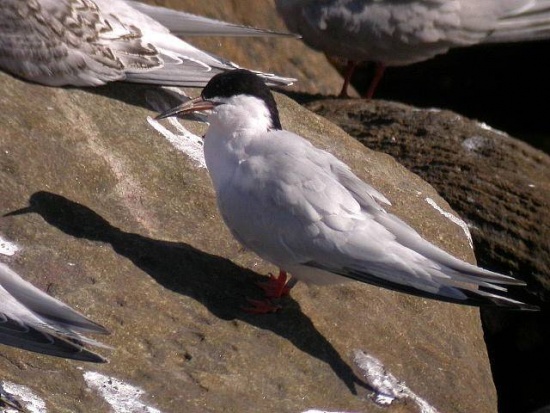(some added text incorporated into article) |
|||
| Line 9: | Line 9: | ||
==Distribution== | ==Distribution== | ||
| − | [[Europe]] and [[North America]]. | + | [[Europe]] and [[North America]].<br /> |
| + | Migrating south in autumn to winter quarters in the [[Caribbean]] and West [[Africa]]. | ||
==Taxonomy== | ==Taxonomy== | ||
==Habitat== | ==Habitat== | ||
| Line 16: | Line 17: | ||
It nests in a ground scrape, often in a hollow or under dense vegetation, and lays 1 or 2 (rarely 3) eggs. | It nests in a ground scrape, often in a hollow or under dense vegetation, and lays 1 or 2 (rarely 3) eggs. | ||
| − | Its diet includes fish. | + | Its diet includes fish. <br /> |
| + | Parents have been recorded teaching and it’s young; this was done by the parent bird catching a fish and then dropping it into the water, the immature bird would then swoop down and take it while the parent follows closely along side. | ||
==External Links== | ==External Links== | ||
{{GSearch|Sterna+dougallii}} | {{GSearch|Sterna+dougallii}} | ||
| Line 23: | Line 25: | ||
[[Category:Birds]][[Category:Sterna]][[Category:Videos]] | [[Category:Birds]][[Category:Sterna]][[Category:Videos]] | ||
| − | |||
Revision as of 12:51, 4 October 2010
| This article is incomplete. This article is missing one or more sections. You can help the BirdForum Opus by expanding it. |
- Sterna dougallii
Identification
33-36 cm.
Thin sharp black bill, with a red base which develops through the breeding season, and is more extensive in the tropical and southern hemisphere races. Upper wings are pale grey and under parts white. The adults have very long, flexible tail streamers and orange-red legs. In summer, the underparts of adults take on the pinkish tinge which gives this bird its name.
Distribution
Europe and North America.
Migrating south in autumn to winter quarters in the Caribbean and West Africa.
Taxonomy
Habitat
Coasts and islands.
Behaviour
It nests in a ground scrape, often in a hollow or under dense vegetation, and lays 1 or 2 (rarely 3) eggs.
Its diet includes fish.
Parents have been recorded teaching and it’s young; this was done by the parent bird catching a fish and then dropping it into the water, the immature bird would then swoop down and take it while the parent follows closely along side.
External Links




